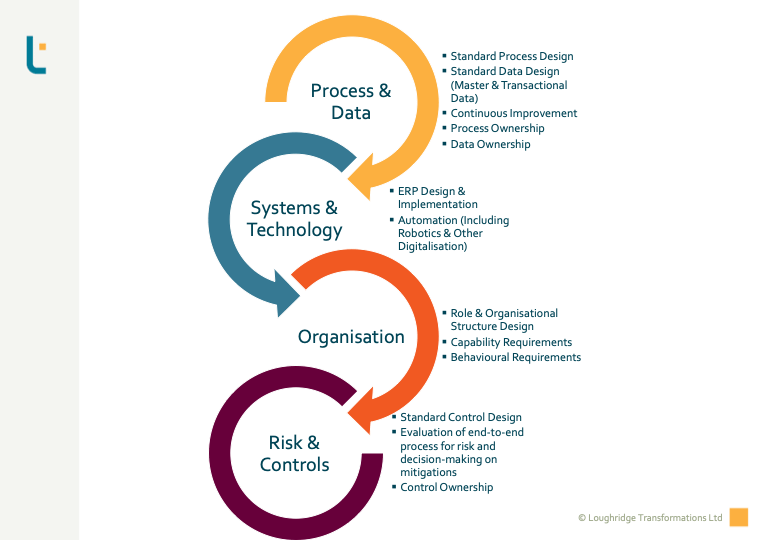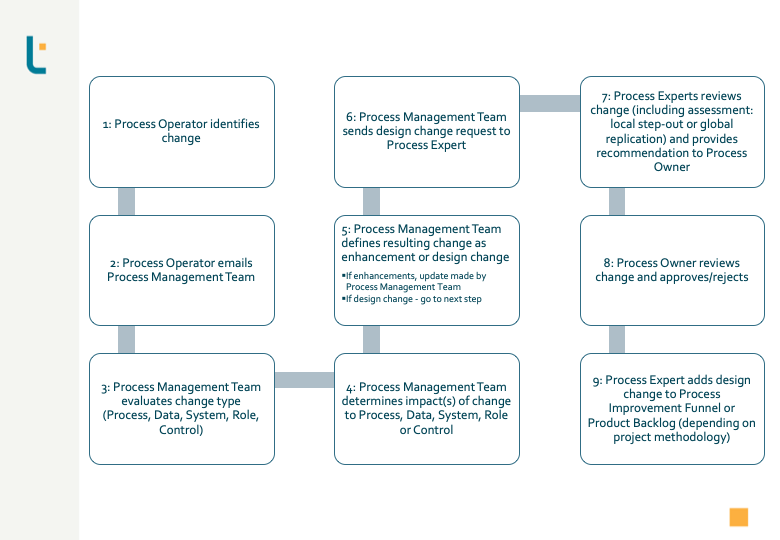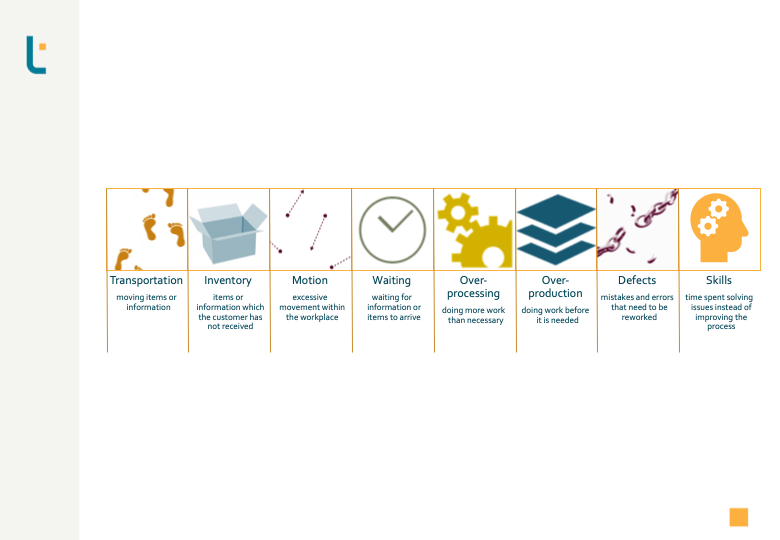Sustain the Change: Finance Transformation to Last

AUTHOR: JENNIFER LOUGHRIDGE
PRINCIPAL CONSULTANT
Jennifer is a Senior Executive Finance professional with 22+ years of global experience. She specialises in Finance Transformation, ESG and Continuous Improvement, with particular expertise in Strategy, Performance Management, Business Partnering, Commercial Decision-Making, Corporate Governance and Valuation.
In our last post in this nine-part series, we looked at Deploy and Transform. We covered the final design steps and the different stages of deployment.
Now, we arrive at the pivotal point in our nine-step journey: Sustain the Change. This step is of utmost importance as it validates the success of the change and ensures its longevity.
This crucial step focuses on making sure that the improvements you’ve worked hard to implement don’t just stick around—they thrive! Sustain the change by creating an environment where success isn’t just an event, but a continuous journey toward excellence. By actively reinforcing the new practices and monitoring their impact, you pave the way for sustainable results that drive your Finance Transformation forward. Let’s ensure that the positive momentum you’ve built keeps gaining strength over time!
The Story So Far
If you have been following the Loughridge Transformations method by now, you will have covered the following steps:
-
Strategy: How to Supercharge Finance Transformation
The Loughridge Transformations approach to strategy.
-
Finance Functional Fit: The Most Critical Scope Definition You Need
The Loughridge Transformations method of determining the Finance Functional Fit – the most critical scope definition you need.
-
Baseline Definition – A Reliable Assessment Model for the Finance Function
Learn how Loughridge Transformations effectively evaluates baseline data to achieve successful Finance Transformation.
-
Define the Future – Target Setting & Benchmarking
The Loughridge Transformations structured approach to working with benchmarks and establishing targets for Finance Transformation.
-
Choose The Lever for Successful Finance Transformation
The Loughridge Transformations method of Finance Transformation: Choose The Lever – discover the tools and strategies that will set you on the path to achieving targets.
-
Finance Transformation: Understand The Context to Secure Excellence
Examining the importance of understanding what’s happening around you and identifying what could impact your Finance Transformation.
-
Power Up the Design and Ensure Robust Finance Transformation
The Loughridge Transformations approach to delivering the design phase of projects.
-
Deployment for Finance Transformation: Ensuring a Successful Go-Live
The Loughridge Transformations approach to the implementation phase of projects.
At this last stage, we turn our attention to validating that the changes are successful and ensuring that the changes are sustainable for the future – sustaining the change.
Validating the Change
Sustain the Change: Monitoring Process Performance
As you transition to Standalone Go-Live, the focus shifts to process performance. Here, the use of Key Performance Indicators (KPIs) becomes crucial. They serve as a reliable tool to monitor and ensure the performance is not just acceptable but also improving towards top-quartile or world-class levels.
For instance, imagine you have improved the financial closing process. Before the improvement, the team completed the close on WorkDay +10. The new closing target is WorkDay +7. Consequently, the KPI becomes which WorkDay the closing is complete. Nevertheless, you may find that, during the stabilisation phase, closing finishes on WorkDay +8 or even +9.
Sustain the Change: Reaching Target Performance
However, remember that reaching the target may take time. Therefore, it is time to identify any remaining blockers to achieve the target KPI. For example, you might find that closing Accounts Payable on WorkDay -1 (rather than WorkDay +1) saves a whole day in the closing process.
The insight gained through KPI monitoring will allow you to make the necessary improvements proactively. Moreover, when correctly set up, KPIs also enable you to measure the effectiveness of the improvement project. This approach ensures the long-term sustainability of your organisation’s operating model and will, in many cases, help increase value.
Ensuring Sustainability
To ensure sustainability, you must first consider how you will keep the design up-to-date. Secondly, think about how to maintain design compliance. Thirdly, decide how to deal with legal and fiscal requirements outside the design. Finally, you should classify any acceptable deviation from the original design as a “step-out” and fully document and seek approval from the appropriate governance body.
Sustain the Change: Process Governance
Rolling out or deploying global processes across several geographies while ensuring sustainability can often be challenging. Process governance, through global process owners (GPOs), is vital to mitigate the risk of unwanted divergence from the process, data, role or control design.
What should the Global Process Owners’ role be?
GPOs act as the governance body for the design and have authority over design changes. The GPO is typically accountable for the following:

Process Visionary or Process Operator?
Should the GPO be responsible for today’s As-Is and tomorrow’s To-Be processes?
There is no simple answer. It rather depends on where your organisation is in the transformation journey. Ordinarily, the answer is “yes” – they are responsible for both. However, in a mature standard design environment, the accountability of the GPO will focus mainly on the operation, maintenance and improvement of the existing standards.
Practically speaking, using the Shared Service Centre example again, the answer would be “yes”. Here, the organisation is at the start of the transformation journey. As such, the GPO needs to articulate the business case for the change. They will work with decision-makers and have a role in cascading the message further in the organisation.
In addition to the technical competencies in the process, data, systems, organisation and controls, a GPO should be heavily involved in change management, especially in the early stages of finance transformation.
A GPO will often be critical in telling the story of change, running agile programmes to implement improvements, and leading a growing team of process, data, systems and control experts. As a result, they will manage up, down and across – even convincing some stakeholders that end-to-end process management is essential. It is often a delicate balance between promoting innovation in one breath and trying to halt needless investment in shiny but ineffective technology. They will usually have to convince others that the intention is not to create a “process nirvana”. Furthermore, some may see them as an “overhead” and a challenge to other leaders’ authority.
GPO Activities
Defining the scope of a GPO can be complicated. For example, in many organisations, an ERP or other technology implementation is the trigger for looking at processes. As a result, favouring a narrow technology view over an end-to-end process view can be a risk.
Take Order to Cash (OtC) as an example – if you do not take the time and effort to understand the process’s correct start and end points, you may miss elements. The OtC process spans many activities: sales, credit management, cash management, general ledger entries, reporting, and more. If a systems-only lens is applied, ensuring everything is appropriately considered when designing the standard process and all that goes with it can be challenging.
GPO Authority and Resources
Ultimately, the GPO needs authority over all standard design aspects: process, data, systems, organisation and controls. These elements are too interconnected not to sit under the same governance. Therefore, good governance is critical; otherwise, excellent design work is at considerable risk.
The GPO will need to be active in the initial design and then the operation, maintenance and improvement of the standards. They ensure that the organisation replicates the enhancements globally and minimises “step-outs”. They will need the competencies, skills, authority and resources to deliver accordingly.
Two factors influence the level of resourcing a GPO will require. First, the larger and more complex the overall organisation, the larger the team needed to handle design and operational issues. Second, GPO activities in the early phases of transformation are more resource-intensive and require different skills. Therefore, a GPO needs a team with the appropriate number of resources and a diversity of skills.
Sustain the Change: Management of Change
In addition to operational enhancements, there are many legitimate reasons for design changes over time. New systems, increased automation and changes in the regulatory environment are just a few examples.
These global design changes must be released and rolled out properly, whichever agile or continuous improvement methods your organisation uses. A typical procedure could look as follows:

You must also communicate the new change procedure to all relevant stakeholders and users. The work instructions for each process should identify the roles participating in the end-to-end process. Therefore, this list of roles is an ideal starting point for change communication. However, remember that there may well be other stakeholders to include in the communication.
Furthermore, it is critical to communicate all process updates to process operators. If the update or change involves a change in the design, you also need to consider potential training requirements. Depending on the size and nature of the change, it may constitute project scope in its own right and lead to a project with subsequent deployment.
Sustain the Change: Performance Management & Improvement
So far, we have talked mainly about reacting to changes needed post-deployment. However, to sustain change properly, we must also consider proactively identifying improvements to the process.
Building in continuous improvement elements and ensuring global enhancements replication is essential during process design. That could be in the process itself, but certainly in the skills and behaviours of the process teams.
Visual Management is an excellent way to encourage teams to identify and implement improvements from their day-to-day experience operating the process. These four components of visual management below support teams on a practical level:

Using a TIMWOOD(S) structure can also help teams approach improvement identification easily and practically.

Let’s examine how this can help a team. We will use the familiar financial closing process as an example. In this illustration, the newly designed closing process includes a step to review it each month after the close.
When the team performs this monthly review, they notice an increasing volume of Manual Journal Entries. This is not surprising; many organisations struggle with this, after all. Studies in some organisations have shown that up to 80% of the entries are not material for closing purposes.
Having identified the topic, the team then uses TIMWOOD(S) to help them dig deeper to find the causes. Here are some of the things they see:

Transportation
Design: Manual Journal Entries approved via workflow
Reality: Some process operators are requesting approval via e-mail before posting

Inventory
Design: Manual Journal Entries approved via workflow
Reality: Some journals were not posted. The poster sought approval by e-mail. The approver focussed on the workflow and did not check their inbox, so they did not approve.

Motion
Design: Physical signatures are not required, so functionality was not switched on in the workflow
Reality: In one country, physical signatures are required as evidence of approval by fiscal authorities. Journals are printed and carried over to the approver for signature before being scanned and posted.

Waiting
Design: Journals arrive as per the closing schedule
Reality: Journals arrive after the deadline, which delays the next step in the process

Over-processing
Design: A materiality threshold is in place for manual journal entries
Reality: Journals below the threshold are posted

Over-production
Design: Analysis starts when all journals are posted
Reality: Journals are posted late. Analysis has already begun and needs to be re-worked

Defects
Design: ERP-driven postings are correct
Reality: Errors in ERP-driven postings require additional manual journals to make corrections

Skills
Design: A monthly review after each close to identify improvements
Reality: The review happened after the quarter close, but the previous two months were skipped because the closing was delayed due to the late posting of journals mentioned in over-production
Next, the team think about their Visual Management. Here are a few of the points they come up with:
| Order | Are the work instructions clear enough? |
| Standards | Would screenshots in the work instructions help? |
| Metrics | Can the performance dashboard be updated to identify from which department the late journals originate? |
| Controls | Can we introduce a warning sign on the journal template to alert us if the value is below the materiality threshold? |
At this point, the design change procedure we have detailed above will take effect. A team member would then contact the Process Management Team to evaluate the requested changes.
This example demonstrates the importance of sustainability in standard design. Without the possibility of evolving, the standards will become obsolete, and operational practice will deviate from the design. This design deviation, in turn, undermines the investment made and lowers the return. Many organisations face challenges in the sustainability of design standards. Loughridge Transformations can support you in implementing procedures and ways of working to ensure you can sustain the change and offer workshops and other services to deliver this.
And so the Cycle Begins…
With that, we have reached the end of the Loughridge Transformations method of Finance Transformation. Having identified a new batch of improvements for the next release, you can return to the first step to ensure your subsequent releases are as successful and sustainable as the first and continue your journey to world-class performance!
Interested in More Finance Transformation?
This post was the last of the nine posts in this series. Look out for the upcoming summary of the method, or take a look at some of the posts you may have missed:
-
Nine Steps to Finance Transformation
An introduction to a series of blog posts on nine scalable and modular steps to deliver successful and sustainable Finance Transformation.
-
Strategy: How to Supercharge Finance Transformation
The Loughridge Transformations approach to strategy.
-
Finance Functional Fit: The Most Critical Scope Definition You Need
The Loughridge Transformations method of determining the Finance Functional Fit – the most critical scope definition you need.
-
Baseline Definition – A Reliable Assessment Model for the Finance Function
Learn how Loughridge Transformations effectively evaluates baseline data to achieve successful Finance Transformation.
-
Define the Future – Target Setting & Benchmarking
The Loughridge Transformations structured approach to working with benchmarks and establishing targets for Finance Transformation.
-
Choose The Lever for Successful Finance Transformation
The Loughridge Transformations method of Finance Transformation: Choose The Lever – discover the tools and strategies that will set you on the path to achieving targets.
-
Finance Transformation: Understand The Context to Secure Excellence
Examining the importance of understanding what’s happening around you and identifying what could impact your Finance Transformation.
-
Power Up the Design and Ensure Robust Finance Transformation
The Loughridge Transformations approach to delivering the design phase of projects.
-
Deployment for Finance Transformation: Ensuring a Successful Go-Live
The Loughridge Transformations approach to the implementation phase of projects.
-
Sustain the Change: Finance Transformation to Last
The Loughridge Transformations way to actively reinforce the new practices and monitor their impact to pave the way to drive your Finance Transformation forward
-
Reviewing the Nine Steps to Finance Transformation
A summary of the series of blog posts on nine scalable and modular steps to deliver successful and sustainable Finance Transformation.
If you would like to speak with one of our consultants to discuss the above, please feel free to contact us!
Alternatively, take a look at our most popular blog posts:
Or are you looking for something else? Here’s what we have been blogging about recently:
Agile Analytics Associates Automation Behaviours Building Trust Business-Partnering CFO Remit Change Management Coaching Collaboration Continuous Improvement Control Design Corporate Governance Data Deployment Digital ERP ESG Finance Function Finance Transformation Implementation Migration Off-Shoring Organisation Organisation Design Process Process Design Process Governance Process Improvement Process Performance Productivity Project Management Readiness Risk & Controls Skills Solution Selection sponsorship Standard Organisational Model Strategy Systems Systems Design Technology Transformation Virtual Working
